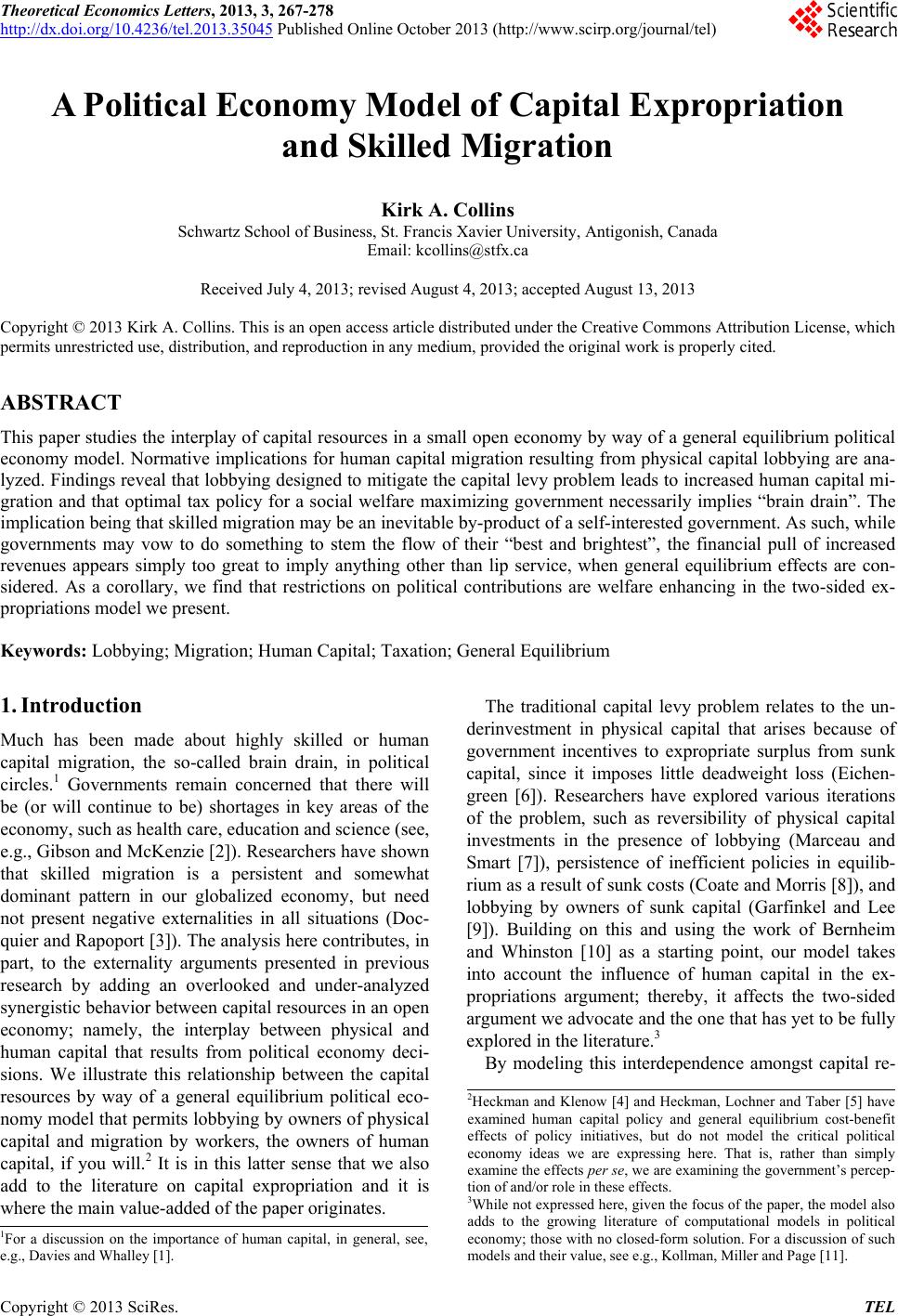 Theoretical Economics Letters, 2013, 3, 267-278 http://dx.doi.org/10.4236/tel.2013.35045 Published Online October 2013 (http://www.scirp.org/journal/tel) A Political Economy Model of Capital Expropriation and Skilled Migration Kirk A. Collins Schwartz School of Business, St. Francis Xavier University, Antigonish, Canada Email: kcollins@stfx.ca Received July 4, 2013; revised August 4, 2013; accepted August 13, 2013 Copyright © 2013 Kirk A. Collins. This is an open access article distributed under the Creative Commons Attribution License, which permits unrestricted use, distribution, and reproduction in any medium, provided the original work is properly cited. ABSTRACT This paper studies the interplay of capital reso urces in a small open economy by way of a general equilibrium political economy model. Normative implications for hu man capital migration resultin g from physical capital lobbying are ana- lyzed. Findings reveal that lobbying designed to mitigate the capital levy problem leads to increased human capital mi- gration and that optimal tax policy for a social welfare maximizing government necessarily implies “brain drain”. The implication being that skilled migr ation may be an inevitable by-product of a self-interested government. As such, while governments may vow to do something to stem the flow of their “best and brightest”, the financial pull of increased revenues appears simply too great to imply anything other than lip service, when general equilibrium effects are con- sidered. As a corollary, we find that restrictions on political contributions are welfare enhancing in the two-sided ex- propriations model we present. Keywords: Lobbying; Migration; Human Capital; Taxation; General Equilibrium 1. Introduction Much has been made about highly skilled or human capital migration, the so-called brain drain, in political circles.1 Governments remain concerned that there will be (or will continue to be) shortages in key areas of the economy, such as health care, education and science (see, e.g., Gibson and McKenzie [2]). Researchers have shown that skilled migration is a persistent and somewhat dominant pattern in our globalized economy, but need not present negative externalities in all situations (Doc- quier and Rapoport [3]). The analysis here contributes, in part, to the externality arguments presented in previous research by adding an overlooked and under-analyzed synergistic behavior between capital resources in an open economy; namely, the interplay between physical and human capital that results from political economy deci- sions. We illustrate this relationship between the capital resources by way of a general equilibrium political eco- nomy model that permits lobbying by owners of physical capital and migration by workers, the owners of human capital, if you will.2 It is in this latter sense that we also add to the literature on capital expropriation and it is where the main value -ad ded of the paper originates. The traditional capital levy problem relates to the un- derinvestment in physical capital that arises because of government incentives to expropriate surplus from sunk capital, since it imposes little deadweight loss (Eichen- green [6]). Researchers have explored various iterations of the problem, such as reversibility of physical capital investments in the presence of lobbying (Marceau and Smart [7]), persistence of inefficient policies in equilib- rium as a result of sunk costs (Coate and Morris [8]), and lobbying by owners of sunk capital (Garfinkel and Lee [9]). Building on this and using the work of Bernheim and Whinston [10] as a starting point, our model takes into account the influence of human capital in the ex- propriations argument; thereby, it affects the two-sided argument we advocate and the one that has yet to be fully explored in the literature.3 By modeling this interdependence amongst capital re- 2Heckman and Klenow [4] and Heckman, Lochner and Taber [5] have examined human capital policy and general equilibrium cost- enefit effects of policy initiatives,but do not model the critical political economy ideas we are expressing here. That is, rather than simply examine the effects per se, we are examining the government’s percep- tion of and/or role in these effects. 3While not expressed here, given the focus of the paper, the model also adds to the growing literature of computational models in political economy; those with no closed-form solution. For a discussion of such models and their value,see e.g.,Kollman, Miller and Page [11]. 1For a discussion on the importance of human capital, in general, see, e.g., Davies and Whalley [1]. C opyright © 2013 SciRes. TEL 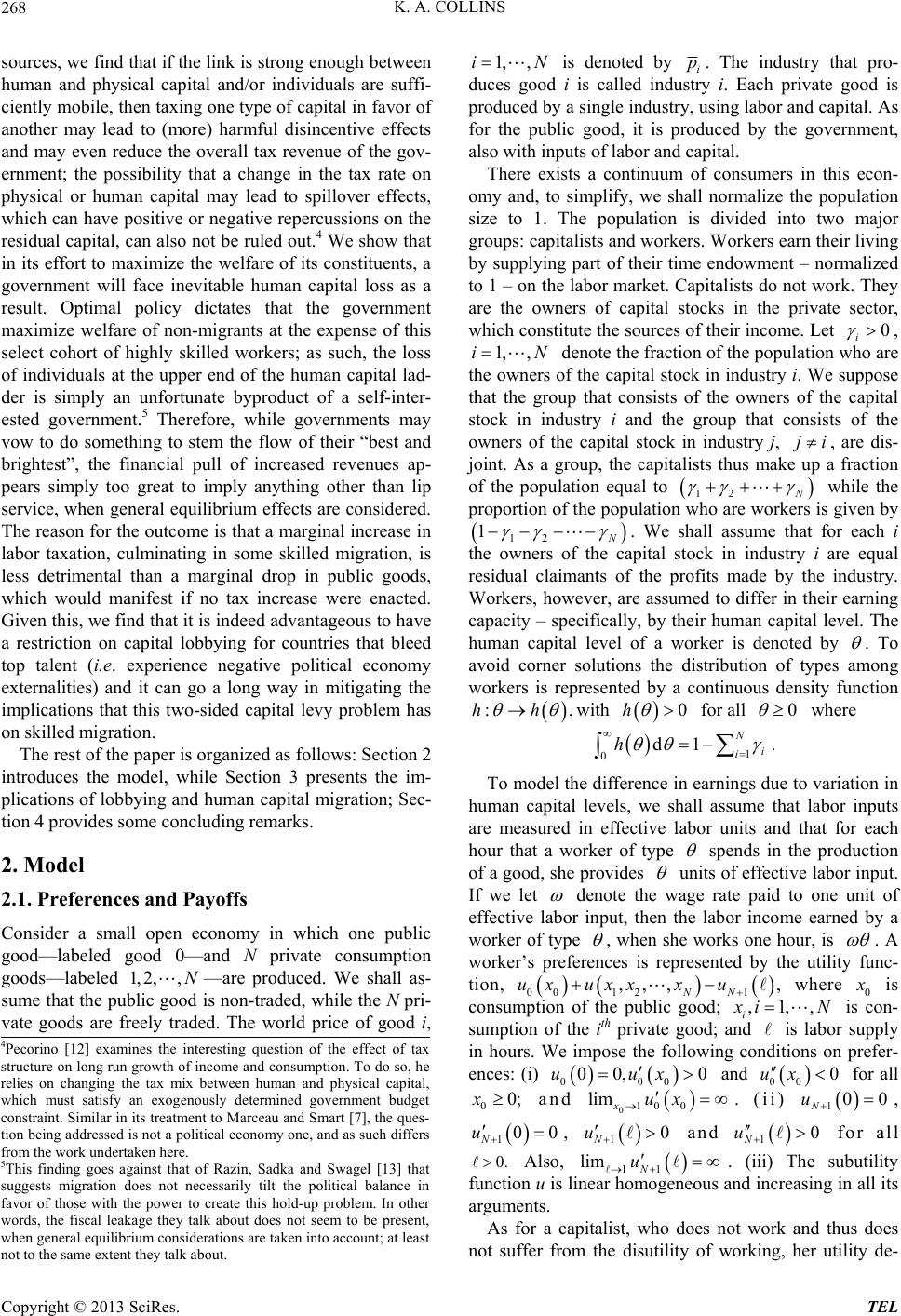 K. A. COLLINS 268 sources, we find that if th e link is strong enou gh between human and physical capital and/or individuals are suffi- ciently mobile, then taxing one type of capital in favor of another may lead to (more) harmful disincentive effects and may even reduce the overall tax revenue of the gov- ernment; the possibility that a change in the tax rate on physical or human capital may lead to spillover effects, which can have positive or negative repercu ssions on the residual capital, can also not be ruled out.4 We show that in its effort to maximize the welfare of its constituents, a government will face inevitable human capital loss as a result. Optimal policy dictates that the government maximize welfare of non-migrants at the expense of this select cohort of highly skilled workers; as such, the loss of individuals at the upper end of the human capital lad- der is simply an unfortunate byproduct of a self-inter- ested government.5 Therefore, while governments may vow to do something to stem the flow of their “best and brightest”, the financial pull of increased revenues ap- pears simply too great to imply anything other than lip service, when general equilibrium effects are considered. The reason for the outcome is that a marginal increase in labor taxation, culminating in some skilled migration, is less detrimental than a marginal drop in public goods, which would manifest if no tax increase were enacted. Given this, we find that it is indeed advantageous to have a restriction on capital lobbying for countries that bleed top talent (i.e. experience negative political economy externalities) and it can go a long way in mitigating the implications that this two-sided capital levy problem has on skilled migration. The rest of the paper is organized as follows: Section 2 introduces the model, while Section 3 presents the im- plications of lobbying and human capital migration; Sec- tion 4 provides some concluding remarks. 2. Model 2.1. Preferences and Payoffs Consider a small open economy in which one public good—labeled good 0—and N private consumption goods—labeled —are produced. We shall as- sume that the pub lic good is non-traded, while th e N pri- vate goods are freely traded. The world price of good i, 1, 2,,N 1, ,iN is denoted by i p. The industry that pro- duces good i is called industry i. Each private good is produced by a single industry, using labor and capital. As for the public good, it is produced by the government, also with inputs of labor and capital. There exists a continuum of consumers in this econ- omy and, to simplify, we shall normalize the population size to 1. The population is divided into two major groups: capitalists and workers. Workers earn their living by supplying part of their time endowment – normalized to 1 – on the labor market. Capitalists do not work. They are the owners of capital stocks in the private sector, which constitute the sources of their income. Let 0 i , 1, ,iN denote the fraction of the population who are the owners of the capital stock in industry i. We suppose that the group that consists of the owners of the capital stock in industry i and the group that consists of the owners of the capital stock in industry j, , are dis- joint. As a group, the capitalists thus make up a fraction of the population equal to 12N ji while the proportion of the population who are workers is given by 12 1 . We shall assume that for each i the owners of the capital stock in industry i are equal residual claimants of the profits made by the industry. Workers, however, are assumed to differ in their earning capacity – specifically, by their human capital level. The human capital level of a worker is denoted by . To avoid corner solutions the distribution of types among workers is represented by a continuous density function :,hh with 0h for all 0 where 1 0d1 i i hN . To model the difference in earnings due to variation in human capital levels, we shall assume that labor inputs are measured in effective labor units and that for each hour that a worker of type spends in the production of a good, she provid es units of effective labor input. If we let denote the wage rate paid to one unit of effective labor input, then the labor income earned by a worker of type , when she works one hour, is . A worker’s preferences is represented by the utility func- tion, ,x 1 ,, , NN xxu 00 ux 12 where 0 u is consumption of the public good; ,1 i,, i N is con- sumption of the ith private good; and is labor supply in hours. We impose the following conditions on prefer- ences: (i) 0 00, 0uu 0 0 x and 00 0ux for all 4Pecorino [12] examines the interesting question of the effect of tax structure on long run growth of income and consumption. To do so,he relies on changing the tax mix between human and physical capital, which must satisfy an exogenously determined government budget constraint. Similar in its treatment to Marceau and Smart [7], the ques- tion being addressed is not a political economy one, and as such differs from the work undertaken here. 5This finding goes against that of Razin, Sadka and Swagel [13] that suggests migration does not necessarily tilt the political balance in favor of those with the power to create this hold-up problem. In other words, the fiscal leakage they talk about does not seem to be present, when general equilibrium considerations are taken into account; at least not to the same extent they talk about. 0 x0; and 010 0x lim ux . (ii) 00 1N u , 100 N u , 10 N u and for all 10 N u 0. Also, 11 lim N u . (iii) The subutility function u is linear homogeneous and increasin g in all its arguments. As for a capitalist, who does not work and thus does not suffer from the disutility of working, her utility de- Copyright © 2013 SciRes. TEL 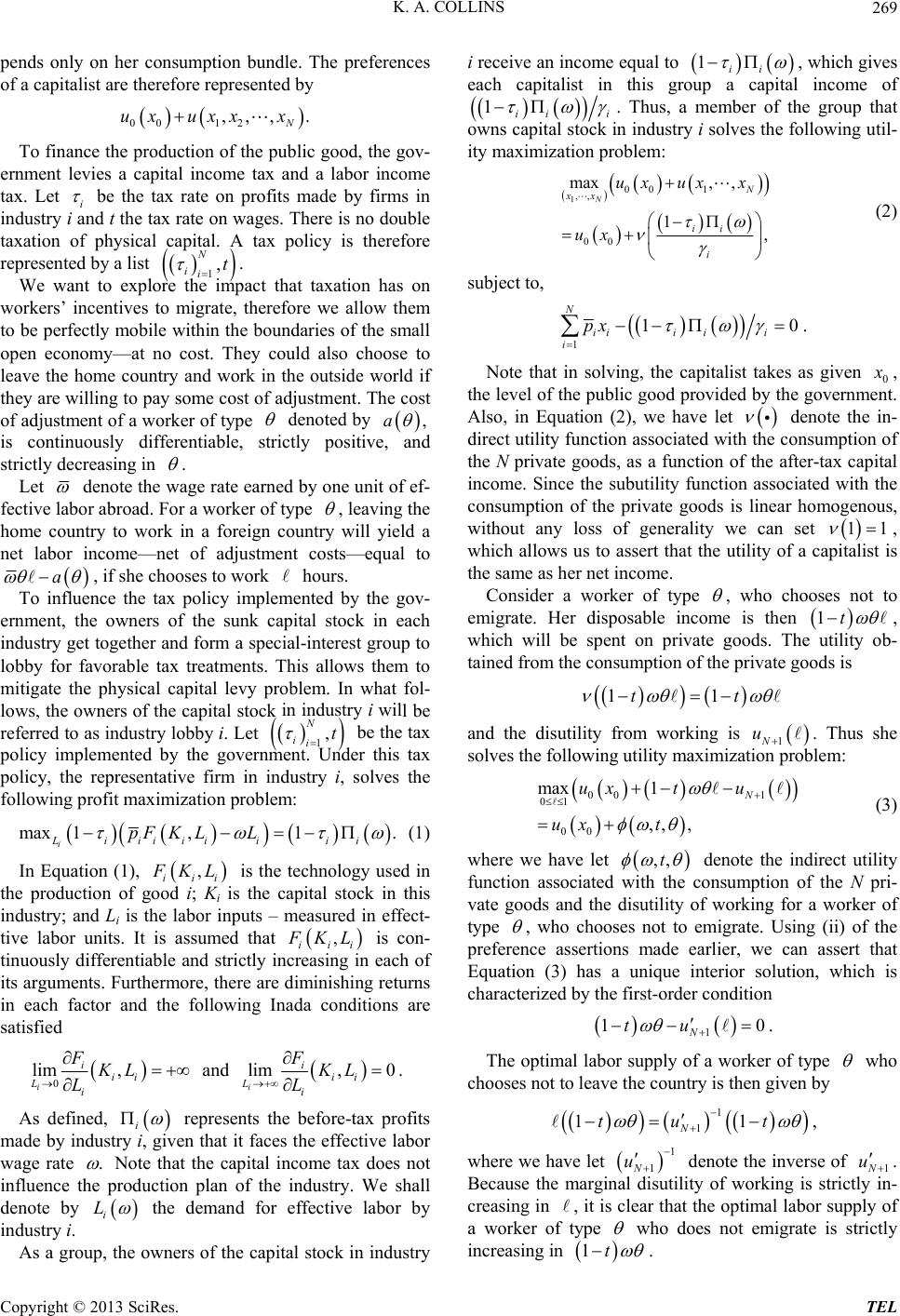 K. A. COLLINS 269 pends only on her consumption bundle. The preferences of a capitalist are therefore represented by 00 12 ,,, . N ux uxxx To finance the production of the pub lic good, the gov- ernment levies a capital income tax and a labor income tax. Let i be the tax rate on profits made by firms in industry i and t the tax rate on w ages. There is no double taxation of physical olicy is therefore represented by a list . capital. A tax p , N it 1i We want to explore the impact that taxation has on workers’ incentives to migrate, therefore we allow them to be perfectly mobile within the boundaries of the small open economy—at no cost. They could also choose to leave the home country and work in the outside world if they are willing to pay some cost of adjustment. Th e cost of adjustment of a worker of type denoted by ,a is continuously differentiable, strictly positive, and strictly decreasing in . Let denote the wage rate earned by one unit of ef- fective labor abroad. Fo r a wo rk er of typ e , leaving the home country to work in a foreign country will yield a net labor income—net of adjustment costs—equal to a in industry i wil , if she chooses to work hours. To influence the tax policy implemented by the gov- ernment, the owners of the sunk capital stock in each industry get together and form a special-interest group to lobby for favorable tax treatments. This allows them to mitigate the physical capital levy problem. In what fol- lows, the owners of the capital stockl be referred to as industry lobby i. Let 1i be the tax policy implemented by the government. Under this tax policy, the representative firm in industry i, solves the following profit maximization problem: , N it max 1,1. i Liiiii iii pF K LL (1) In Equation (1), , iii KL is the technology used in the production of good i; Ki is the capital stock in this industry; and Li is the labor inputs – measured in effect- tive labor units. It is assumed that , iii KL is con- tinuously differentiable and strictly increasing in each of its arguments. Furthermore, there are diminishing returns in each factor and the following Inada conditions are satisfied 0 lim , i iii Li FKL L and lim, 0 i iii Li FKL L . As defined, i represents the before-tax profits made by industry i, given that it faces the effective labor wage rate . Note that the capital income tax does not influence the production plan of the industry. We shall denote by i L the demand for effective labor by industry i. As a group, the owners of the capital stock in industry i receive an income equal to 1ii , which gives each capitalist in this group a capital income of 1ii i . Thus, a member of the group that owns capital stock in industry i solves the following util- ity maximization problem: 100 1 ,, 00 max, , 1, NN xx ii i ux uxx ux (2) subject to, 110 N iii ii i px . Note that in solving, the capitalist takes as given 0 , the level of the public good provided by th e government. Also, in Equation (2), we have let denote the in- direct utility function associated with the consu mption of the N private goods, as a function of the after-tax capital income. Since the subutility function associated with the consumption of the private goods is linear homogenous, without any loss of generality we can set 11 , which allows us to assert that the utility of a capitalist is the same as her net income. Consider a worker of type , who chooses not to emigrate. Her disposable income is then 1t , which will be spent on private goods. The utility ob- tained from the consumption of the pri vat e g oods is 11tt and the disutility from working is . Thus she solves the following utility maximization problem: 1N u 00 1 01 00 max 1 ,, , N uxt u ux t (3) where we have let ,,t denote the indirect utility function associated with the consumption of the N pri- vate goods and the disutility of working for a worker of type , who chooses not to emigrate. Using (ii) of the preference assertions made earlier, we can assert that Equation (3) has a unique interior solution, which is characterized by the first-order condition 1 10 N tu . The optimal labor supply of a worker of type who chooses not to leave the country is then given by 1 1 11 N tu t , where w e have let 1 1N u denote the inverse of 1N u . Because the marginal disutility of working is strictly in- creasing in , it is clear that the optimal labor supply of a worker of type who does not emigrate is strictly increasing in 1t . Copyright © 2013 SciRes. TEL 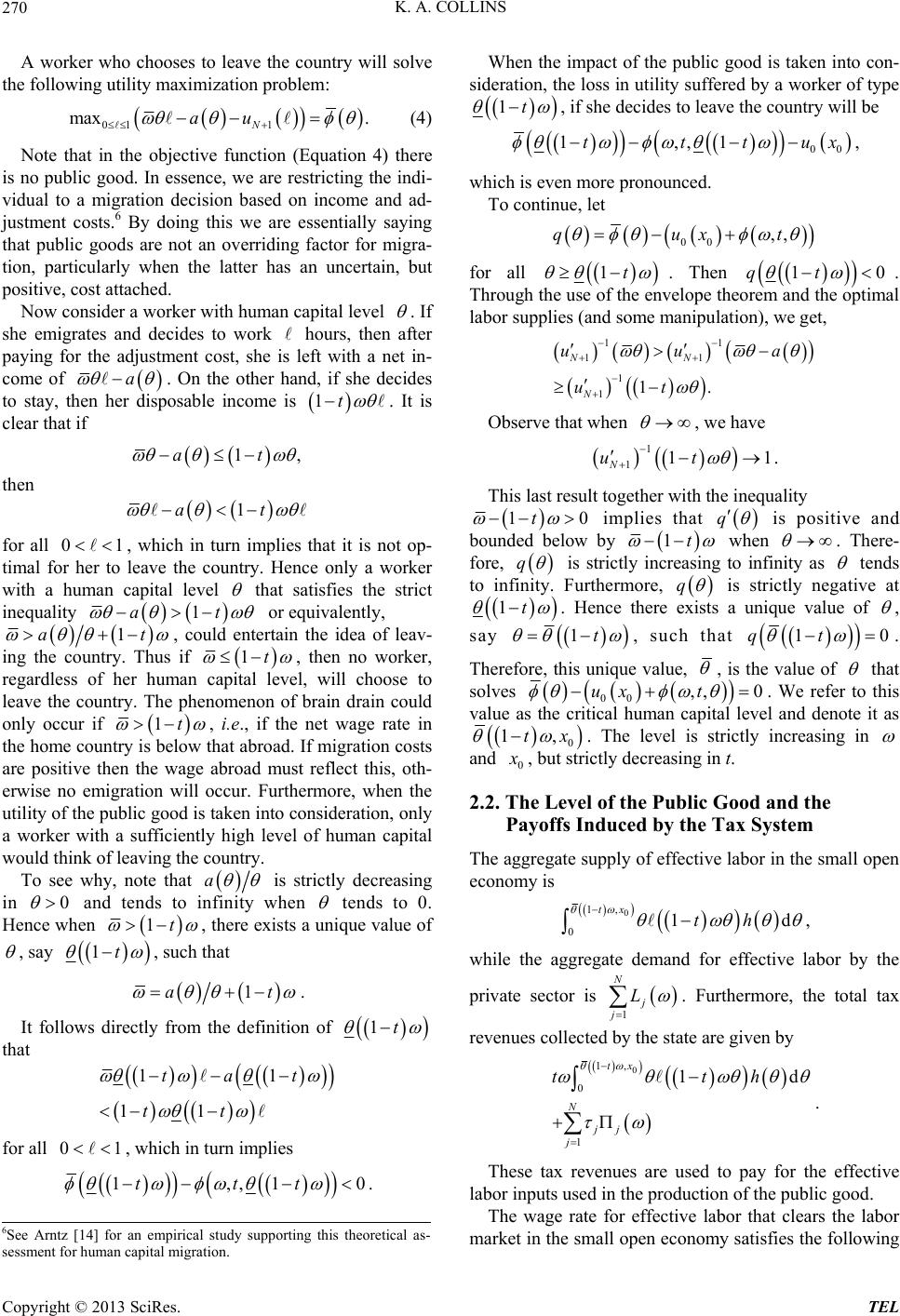 K. A. COLLINS 270 A worker who chooses to leave the country will solve the following utility maximization problem: 01 1 max . N au (4) Note that in the objective function (Equation 4) there is no public good. In essence, we are restricting the indi- vidual to a migration decision based on income and ad- justment costs.6 By doing this we are essentially saying that public goods are not an overriding factor for migra- tion, particularly when the latter has an uncertain, but positive, cost attached. Now consider a worker with human capital level . If she emigrates and decides to work hours, then after paying for the adjustment cost, she is left with a net in- come of a . On the other hand, if she decides to stay, then her disposable income is 1t . It is clear that if 1,at then 1at 1 for all , which in turn implies that it is not op- timal for her to leave the country. Hence only a worker with a human capital level 0 that satisfies the strict inequality 1at or equivalently, 1at , could entertain the idea of leav- ing the country. Thus if t1 , then no worker, regardless of her human capital level, will choose to leave the country. The phenomenon of brain drain could only occur if 1t , i.e., if the net wage rate in the home country is below that abroad. If migration costs are positive then the wage abroad must reflect this, oth- erwise no emigration will occur. Furthermore, when the utility of the public good is taken into consideration, only a worker with a sufficiently high level of human capital would think of leaving the country. To see why, note that a is strictly decreasing in 0 and tends to infinity when tends to 0. Hence when 1t , there exists a unique value of , say 1t , such that 1at . It follows directly from the definition of 1t that 11 11 tat tt 1 for all , which in turn implies 0 1,,1ttt When the impact of the public good is taken into con- sideration, the loss in utility suffered by a worker of type 1t , if she decides to leave the country will be 00 1,,1tttu x, which is even more pronounced. To continue, let 00 ,,quxt for all 1t . Then 10qt . Through the use of the envelope theorem and the optimal labor supplies (and some manipulation), we get, 11 11 1 11. NN N uu ut a Observe that when , we have 1 111 N ut . This last result together with the inequality 1t 0 implies that q is positive and bounded below by 1t when . There- fore, q is strictly increasing to infinity as tends to infinity. Furthermore, q is strictly negative at t1 . Hence there exists a unique value of , say 0. 1t , such that qt 10 . Therefore, this unique value, , is the value of that solves 00 ,, 0ux t . We refer to this value as the critical human capital level and denote it as 0 1,tx . The level is strictly increasing in and 0 , but strictly decreasing in t. 2.2. The Level of the Public Good and the Payoffs Induced by the Tax System The aggregate supply of effective labor in the small open economy is 0 1, 01d tx th , while the aggregate demand for effective labor by the private sector is 1 N j j L . Furthermore, the total tax revenues collected by the state are given by 0 1, 0 1 1d tx N jj j tt h . These tax revenues are used to pay for the effective labor inputs used in the production of the public good. The wage rate for effective labor that clears the labor market in the small open economy satisfies the following 6See Arntz [14] for an empirical study supporting this theoretical as- sessment for human capital migration. Copyright © 2013 SciRes. TEL  K. A. COLLINS 271 market-clearing condition: 0 0 1, 0 1, 0 1 1 1d 1d 1. tx Ntx j j N jj j th Lt th (5) In order for the labor input to be sufficient for produc- ing the amount of public good 0 , the following condi- tion must also be satisfied: 0 1, 00 01 0 1 ,1d . N tx jj j FKtt h x (6) In Equation (6), 000 , KL is the production func- tion used in the production of the public good, where 0 is the stock of public capital and is the input of effective labor. It is assumed that 0 L 000 , KL is con- tinuously differentiable and strictly increasing in each of its variables. Furthermore, the marginal product of labor is strictly decreasing when increases and the Inada conditions are satisfied. 0 L Together, Equations (5) and (6) constitute a system of two equations in two unknowns – and 0 . For any given tax system , we shall let 1, N iit 1, N iit and 01, N ii t be the values of and 0 that solve the system. As defined, is the equi- 1 ii , Nt librium wage paid to one unit of effective labor and 01, N ii t the equilibrium amount of public good produced when the tax system is imposed. 1, N iit N Under the tax policy 1 ii, the critical level of human capital that separates the workers who stay from those who leave the country is ,t 0 11 1,, NN ii ii ttx ,t . To keep the notation from becoming too burdensome, we shall write , instead of 1, N iit 0 11 1,,, NN ii ii ttxt , to denote the critical human capital level. A worker will stay if and only if her type is less than or equal to . For a worker who stays, her utility under 1, N iit the tax policy is given by 1, N iit 00 11 ,, NN ii ii ux ttt,, . As a group, the welfare of the workers who stay is given by 1, 00 1 0 1 00 11 , ,, d ,, N iitN ii N ii NN iii ii ux t tt h ux tHtt 1 ,. N i (7) In Equation (7), we have let H denote the cumu- lative distribution of . Also note that on the right-h and side of Equation (7) the first part gives the utility from the consumption of the public good, while , N it 1i represents the utility from the consumption of the private goods and the disutility of working, for all workers who stay. As for the owners of the capital stock in industry j, 1,, ,jN each of them has a capital income equal to 1 1, N ji itj , which according to our earlier calculations is also the capitalist’s utility from the consumgoods. Her utility under the tax policy is thus given by, ption of private 1, N iit 00 11 1 ,1 , NN ijj ii j ux tt i . Therefore, as a group, the owners of the capital stock in industry j obtain the following utility under the tax policy 1, N iit , 00 11 00 11 ,1 , ,,. NN ji jji ii NN ji ji ii ux tt ux tt (8) In Equation (8), we have l 1,t denote the utility that this group obtains from the consumption et N ji i of the private goods under the tax policy . 1, N iit Without political contributions, the social welfare ob- tained under the tax policy , is given by 1, N iit 1 00 1 11 11 1 , ,, ,,. N ii NN ii ii N NN iji ii j Wt uxt Ht tt N (9) Let ,t 1 ii N be a solution of Equation (9). The equilibrium wage rate and the level of public goods pro- vided under the tax policy are given, re- 1, N iit spectively, by 1, N iit and 01, N ii t . Now define, Copyright © 2013 SciRes. TEL 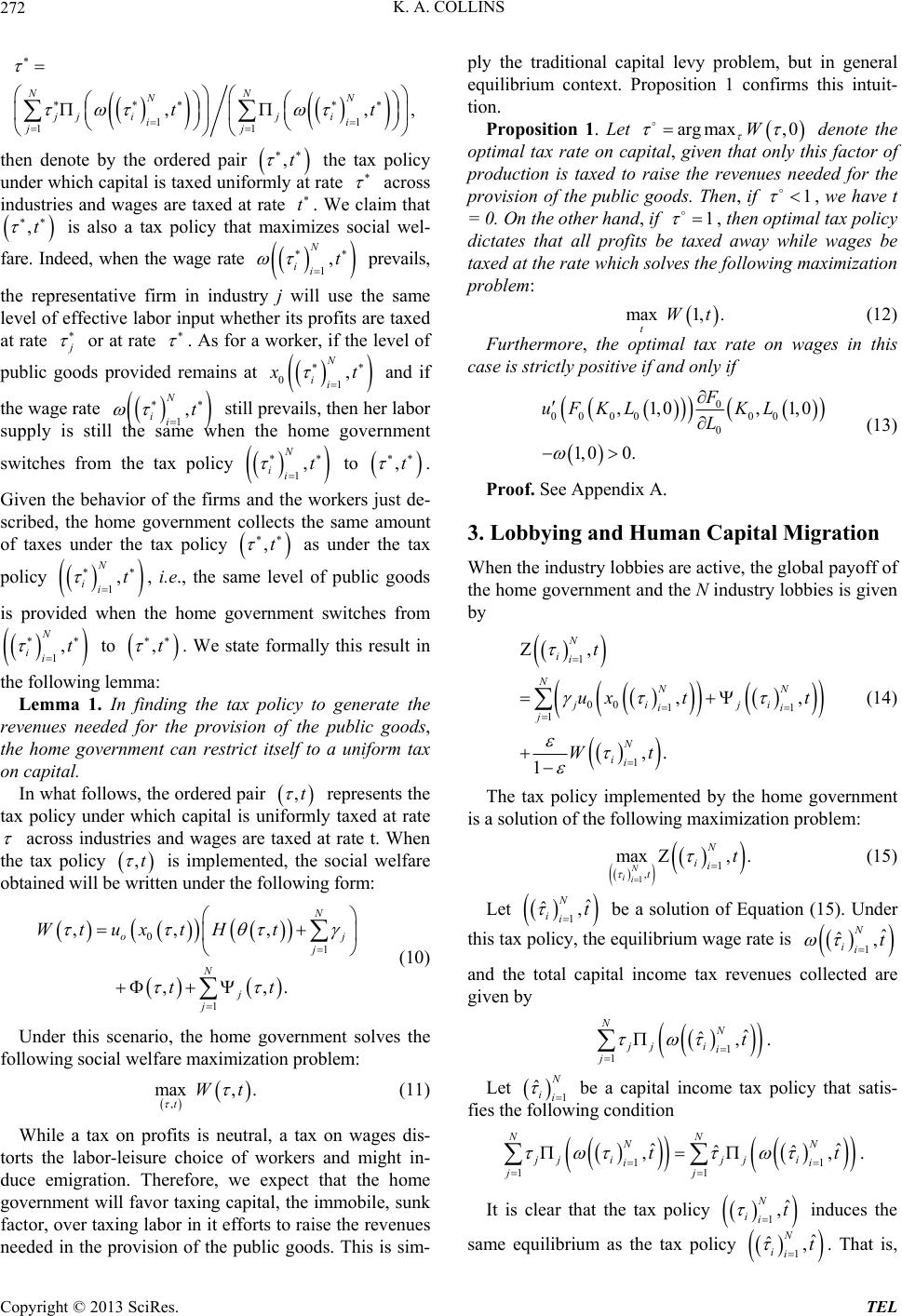 K. A. COLLINS 272 1 11 ,, NN NN jj ij i i jj tt 1 , i then denote by the ordered pair the tax policy under which capital is taxed uniformly at rate ,t across industries and wages are taxed at rate . We claim that is also a tax policy that maximizes social wel- t N ,t fare. Indeed, when the wage rate prevails, 1, iit the representative firm in industry j will use the same level of effective labor input whether its profits are taxed at rate or at rate . As for a worker, if the level of public goods provided remains at 01, N ii t and if the wage rate 1i still prevails, then her labor supply is still the same when the home government , N it switches from the tax policy to 1, N iit ,t . Given the behavior of the firms and the workers just de- scribed, the home government collects the same amount of taxes under the tax policy as under the tax ,t policy , i.e., the same level of public goods 1, N iit is provided when the home government switches from 1, N iit to . We state formally this result in ,t the following lemma: Lemma 1. In finding the tax policy to generate the revenues needed for the provision of the public goods, the home government can restrict itself to a uniform tax on capital. In what follows, the ordered pair ,t represents the tax policy under which capital is uniformly taxed at rate across industries and wages are taxed at rate t. When the tax policy ,t is implemented, the social welfare obtained will be written under the following form: 01 1 ,,, ,,. N o j N j j WtuxtHt tt j (10) Under this scenario, the home government solves the following social welfare maximization problem: , max ,. tWt (11) While a tax on profits is neutral, a tax on wages dis- torts the labor-leisure choice of workers and might in- duce emigration. Therefore, we expect that the home government will favor taxing capital, the immobile, sunk factor, over taxing labor in it efforts to raise the revenues needed in the provision of the public goods. This is sim- ply the traditional capital levy problem, but in general equilibrium context. Proposition 1 confirms this intuit- tion. Proposition 1. Let denote the optimal tax rate on capital, given that only this factor of production is taxed to raise the revenues needed for the provision of the public goods. Then, if , we have t = 0. On the other hand, if , then optimal tax policy dictates that all profits be taxed away while wages be taxed at the rate which solves the following maximization problem: argmax ,0W 1 1 max 1,. tWt (12) Furthermore, the optimal tax rate on wages in this case is strictly positive if and only if 0 0 00000 0 , 1,0, 1,0 1, 00. F uFKL KL L (13) Proof. See Appendix A. 3. Lobbying and Human Capital Migration When the industry lobbies are active, the global payoff of the home government and the N industry lobbies is given by 1 00 11 1 1 , ,, ,. 1 N ii NN ji ji i j N ii t ux tt Wt N i (14) The tax policy implemented by the home government is a solution of the following m a ximization problem: 1 1 , max, . N ii N ii tt (15) Let 1ˆ ˆ, N iit be a solution of Equation (15). Under this tax policy, the equilibrium wage rate is 1ˆ ˆ, N iit and the total capital income tax revenues collected are given by 1 1 ˆ ˆ, NN jj i i j t . Let 1 ˆ i i be a capital income tax policy that satis- fies the following condition 11 11 ˆˆ ˆˆ ,, NN NN jj ijj i ii jj tt . It is clear that the tax policy induces the 1ˆ , N iit N same equilibrium as the tax policy . That is, 1ˆ ˆ, iit Copyright © 2013 SciRes. TEL 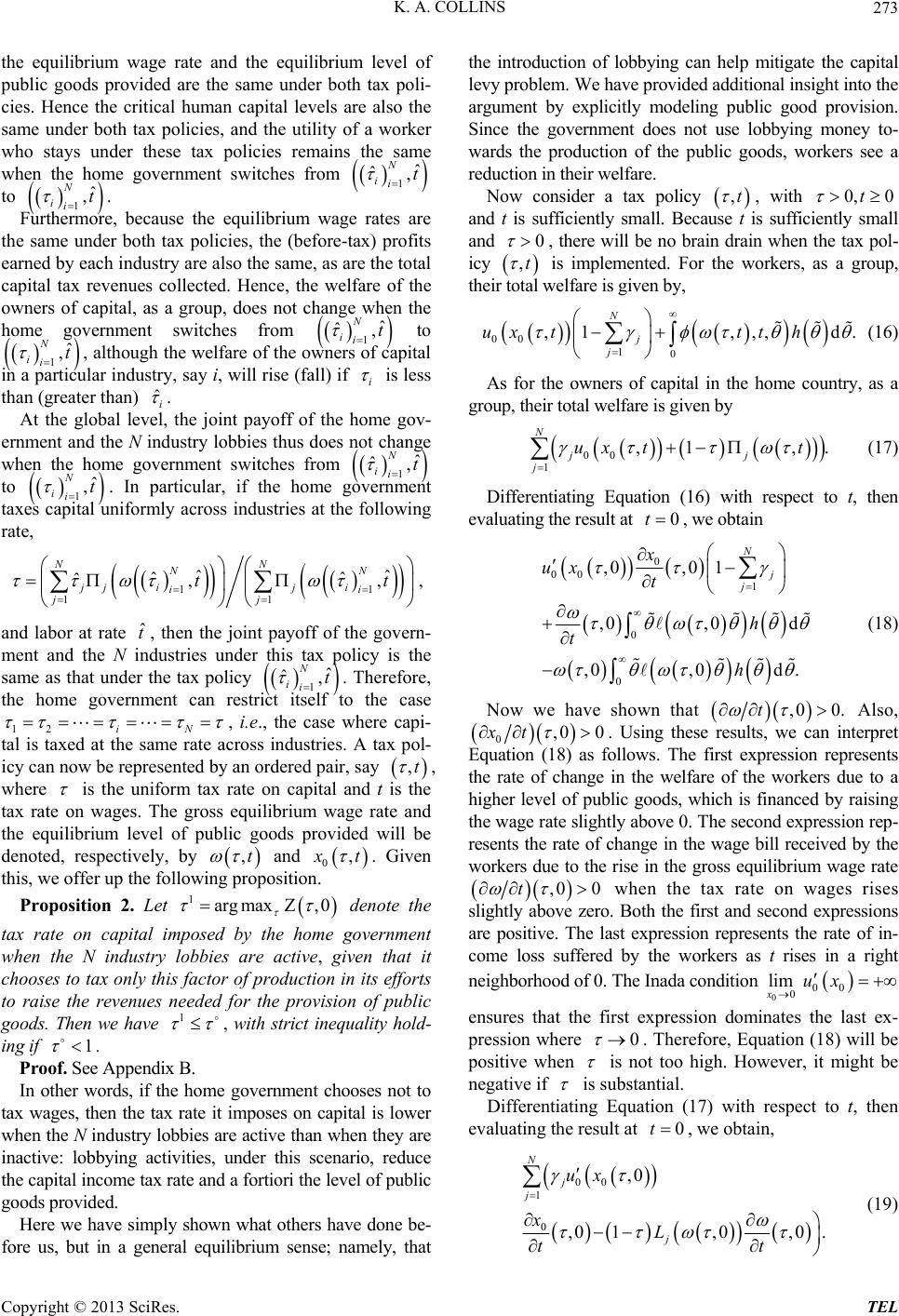 K. A. COLLINS 273 the equilibrium wage rate and the equilibrium level of public goods provided are the same under both tax poli- cies. Hence the critical human capital levels are also the same under both tax policies, and the utility of a worker who stays under these tax policies remains whernment switches from to . the same n the home gove ang men 1ˆ ˆ, N iit e when the ˆ , Nt i ˆ , N it e govern ˆ , N it 1i Furthermore, because the equilibrium wage rates are the same under both tax policies, the (before-tax) profits earned by each industry are also the same, as are the total capital tax revenues collected. Hence, the welfare of the owners of capital, as a group, does not ch homt switches from 1 ii to 1i, although the welfare of the owners of capital in a particular industry, say i, will rise (fall) if ˆ is less than (greater than) ˆi . At the global level, the joint payoff of the home gov- ernment and the N industry lobbies thus does not whernment switches from 1i to 1i. In particular, if the home government taxes capital uniformly across industries at the following rate, change ˆ ˆ, N it n the hom ˆ , N it e gove 11 ˆ ,, NN i ii tt olicy is 11 ˆ ˆˆ NN i j jj this tax p ˆjj , and labor at rate , then the joint payoff of the govern- ment and the N industries under the same as that under the tax policy 1i. Therefore, the home government can restrict itself to the case 12 iN ˆ t ˆ ˆ, N it , i.e., the case where capi- tal is taxed at the same rate across industries. A tax pol- icy can now be represented by an ordered pair, say ,t , where is the uniform tax rate on capital and t is the tax rate on wages. The gross equilibrium wage rate and the equilibrium level of public goods provided will be denoted, respectively, by ,t and 0 , t . Given this, we offer up the following proposition. Proposition 2. Let 1argmax ,0 denote the tax rate on capital imposed by the home government when the N industry lobbies are active, given that it chooses to tax only this factor of production in its efforts to raise the revenues needed for the provision of public goods. Then we have 1 , with strict inequality hold- ing if . 1 Proof. See Appendix B. In other words, if the home government chooses not to tax wages, then the tax rate it imposes on capital is lower when the N industry lobbies are active than when they are inactive: lobbying activities, under this scenario, reduce the capital income tax rate and a fortiori the le vel of public goods provided. Here we have simply shown what others have done be- fore us, but in a general equilibrium sense; namely, that the introduction of lobbying can help mitigate the capital levy problem. We have provided additional insight into the argument by explicitly modeling public good provision. Since the government does not use lobbying money to- wards the production of the public goods, workers see a reduction in their welfare. Now consider a tax policy ,t , with 0,0t and t is sufficiently small. Because t is sufficiently small and 0 , there will be no brain drain when the tax pol- icy ,t is implemented. For the workers, as a group, their total welfare is given by, 00 10 ,1,,, d N j j uxttt h . . (16) As for the owners of capital in the home country, as a group, their total welfare is given by 00 1,1 , N jj j ux tt (17) Differentiating Equation (16) with respect to t, then evaluating the result at 0t , we obtain 0 00 1 0 0 ,0,0 1 ,0,0 d ,0,0d . N j j x ux t h t h (18) Now we have shown that ,0 0.t Also, 0,0 0xt . Using these results, we can interpret Equation (18) as follows. The first expression represents the rate of change in the welfare of the workers due to a higher level of public goods, which is financed by raising the wage rate slightly above 0. The second expression rep- resents the rate of change in the wage bill received by the workers due to the rise in the gross equilibrium wage rate ,0 0t when the tax rate on wages rises slightly above zero. Both the first and second expressions are positive. The last expression represents the rate of in- come loss suffered by the workers as t rises in a right neighborhood of 0. The Inada condition 000 0 lim ux ensures that the first expression dominates the last ex- pression where 0 . Therefore, Equation (18) will be positive when is not too high. However, it might be negative if is substantial. Differentiating Equation (17) with respect to t, then evaluating the result at 0t , we obtain, 00 1 0 ,0 ,01,0,0. N j j j ux xL tt (19) Copyright © 2013 SciRes. TEL  K. A. COLLINS 274 Observe that for each , the expression 1, ,jN 0 00,0 ,0 j x ux t represents the rate of change in the welfare of the own ers of capital in industry j due to a higher level of public goods provided, while the expression 1,0 j Lt,0 represents the loss of capital incomes suffered by this group due to a higher wage bill that the industry pays to its workers. As in the case of workers, the first expres- sion dominates the second expression when is small. However, when is substantial, the summation in Equation (19) might be negative. Under such a scenario, raising the tax rate on wages above zero might make the owners of capital in the home economy worse off as a group. Because the impact on the owners of capital of a rise in the wage rate operates indirectly through the rise in the gross equilibrium wage rate and the rise in the level of public goods provided, while the impact on workers operates both directly – through the reductions in labor income – and ind irectly – through the rise in the level of public goods provided and the rise in the gross equilibrium wage rate – the impacts, when they are nega- tive, are more adverse to the workers. In particular, it is difficult to imagine th at a slight increase in the wage rate above zero will improve the situ ation of the workers, but make the situation of the owners of capital worse off. Therefore, for any 01 , if the home government has already taxed capital at rate and can raise the welfare of the workers by also taxing wages slightly, then this action also raises the welfare of the owners of capital, which leads to the following, Proposition 3. The tax rate on wages will be positive, , if industry lobbies are active. 0t Proof. See Appendix C. Thus, once again in the presence of lobbying firms can alleviate some of their tax burden by providing financial support for a political party’s platform. The resulting lo ss in tax revenues used to fund the provision of the public goods must either be recouped by increasing the taxation on labor income or by redu cing the lev el of public good s. But, any reduction in public goods will lower the welfare of the government’s constituents by a larger amount, than a small increa se in inco me taxes. Therefore, taxes on labor income rise in the presence of lobbying and the govern- ment concedes the resulting migration by some highly skilled labor in an effort to make the remaining constitu- ents better off, thereby ensuring its persistence in office. While no dependence of unskilled on skilled labor is built into the model, it is not hard to imagine that if skilled labor leads to job creation for unskilled workers, the reduction at the upper end of the human capital scale will intensify the negative spillover effects. This type of argument would exacerbate the implications of our find- ings for countries that bleed talent, in particular, or, at least, have an inequitable impact on skill differential be- tween those that leave versus enter from abroad. As such, a restriction on capital lobbying would likely imply a more efficient solution. 4. Concluding Remarks By modeling the two-sided expropriations problem, we have shown how changes in tax policy can influence mi- gration patterns of skilled workers. By doing so, we have explored some indirect implications of the traditional problem which has yet to be examined. For example, whether or not a country is human capital intensive will depend directly on the taxation of skilled labor and its mobility and indirectly on policies guiding political con- tributions and capital income taxes. The more lax the policies are on the indirect effects, the greater the direct incentives for mig ration of highly sk illed ind ividuals will be. Modeling the expropriation decision in a general equi- librium framework also affords a commentary on the externality caused b y physical cap ital lobb ying on h uman capital migration. For example, all else being equal, if adjustment costs rise in the home country, then a greater number of highly skilled workers remain and the econ- omy is now more human capital intensive; this, accord- ing to endogenous growth theory, leads to an improved economic outlook. Of cou rse, this goes for countries that bleed talent. For countries that rely on attracting skilled labor from abroad, the results are the opposite. If migra- tion costs rise, then fewer workers are choosing to emi- grate. Therefore, countries that relied on skilled labor to supplement their workforce may fall short of their nec- essary requirements. Finally, we show that while equilibrium under social welfare maximization calls for a high capital income tax. This result falls apart with the allowance of lobbying. Fortunately, the mobility of skilled labor provides a de- terrent to the government when determining the stru cture of taxation. Hence, labor income taxation remains low even in the face of lobbying. This result casts doubt on previous findings that believe restrictions on lobbying have ambiguous results (e.g. Marceau and Smart [7]). Certainly, in our framework such restrictions appear to be positive in terms of providing increased welfare for government constituents. To be fair, unlike Marceau and Smart [7], we include a labor-migration choice for a worker, which acts as a constraint. REFERENCES [1] J. B. Davies and J. Whalley, “Taxes and Capital Forma- Copyright © 2013 SciRes. TEL 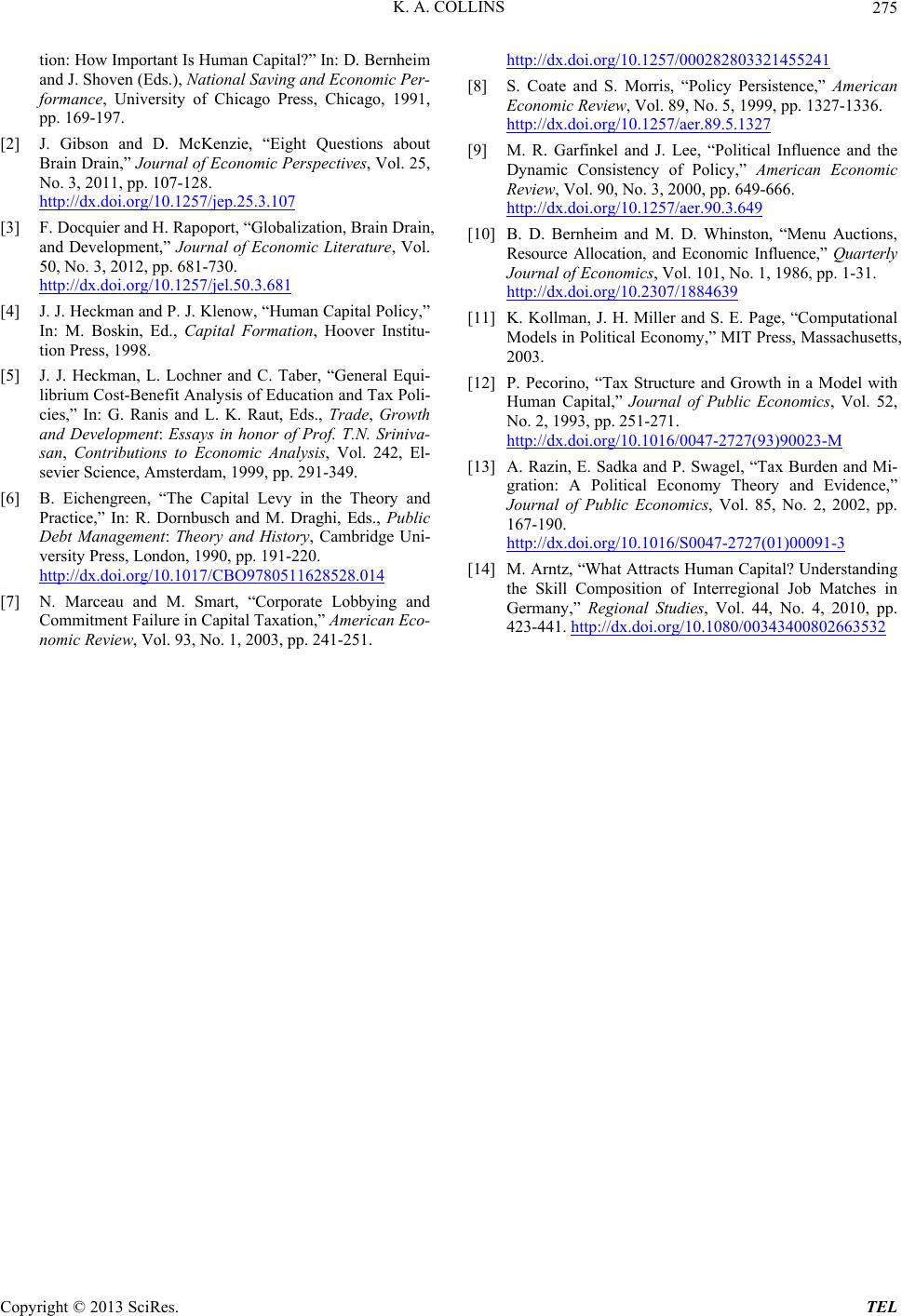 K. A. COLLINS Copyright © 2013 SciRes. TEL 275 tion: How Important Is Human Capital?” In: D. Bernheim and J. Shoven (Eds.), National Saving and Economic Per- formance, University of Chicago Press, Chicago, 1991, pp. 169-197. [2] J. Gibson and D. McKenzie, “Eight Questions about Brain Drain,” Journal of Economic Perspectives, Vol. 25, No. 3, 2011, pp. 107-128. http://dx.doi.org/10.1257/jep.25.3.107 [3] F. Docquier and H. Rapoport, “Globalization, Brain Drain, and Development,” Journal of Economic Literature, Vol. 50, No. 3, 2012, pp. 681-730. http://dx.doi.org/10.1257/jel.50.3.681 [4] J. J. Heckma n and P. J. Klenow, “Human Capital Policy,” In: M. Boskin, Ed., Capital Formation, Hoover Institu- tion Press, 1998. [5] J. J. Heckman, L. Lochner and C. Taber, “General Equi- librium Cost-Benefit Analysis of Education and Tax Poli- cies,” In: G. Ranis and L. K. Raut, Eds., Trade, Growth and Development: Essays in honor of Prof. T.N. Sriniva- san, Contributions to Economic Analysis, Vol. 242, El- sevier Science, Amsterdam, 1999, pp. 291-349. [6] B. Eichengreen, “The Capital Levy in the Theory and Practice,” In: R. Dornbusch and M. Draghi, Eds., Public Debt Management: Theory and History, Cambridge Uni- versity Press, London, 1990, pp. 191-220. http://dx.doi.org/10.1017/CBO9780511628528.014 [7] N. Marceau and M. Smart, “Corporate Lobbying and Commitment Failure in Capital Taxation,” American Eco- nomic Review, Vol. 93, No. 1, 2003, pp. 241-251. http://dx.doi.org/10.1257/000282803321455241 [8] S. Coate and S. Morris, “Policy Persistence,” American Economic Review, Vol. 89, No. 5, 1999, pp. 1327-1336. http://dx.doi.org/10.1257/aer.89.5.1327 [9] M. R. Garfinkel and J. Lee, “Political Influence and the Dynamic Consistency of Policy,” American Economic Review, Vol. 90, No. 3, 2000, pp. 649-666. http://dx.doi.org/10.1257/aer.90.3.649 [10] B. D. Bernheim and M. D. Whinston, “Menu Auctions, Resource Allocation, and Economic Influence,” Quarterly Journal of Economics, Vol. 101, No. 1, 1986, pp. 1-31. http://dx.doi.org/10.2307/1884639 [11] K. Kollman, J. H. Miller and S. E. Page, “Computational Models in Political Economy,” MIT Press, Massachusetts, 2003. [12] P. Pecorino, “Tax Structure and Growth in a Model with Human Capital,” Journal of Public Economics, Vol. 52, No. 2, 1993, pp. 251-271. http://dx.doi.org/10.1016/0047-2727(93)90023-M [13] A. Razin, E. Sadka and P. Swagel, “Tax Burden and Mi- gration: A Political Economy Theory and Evidence,” Journal of Public Economics, Vol. 85, No. 2, 2002, pp. 167-190. http://dx.doi.org/10.1016/S0047-2727(01)00091-3 [14] M. Arntz, “What Attracts Human Capital? Understanding the Skill Composition of Interregional Job Matches in Germany,” Regional Studies, Vol. 44, No. 4, 2010, pp. 423-441. http://dx.doi.org/10.1080/00343400802663532 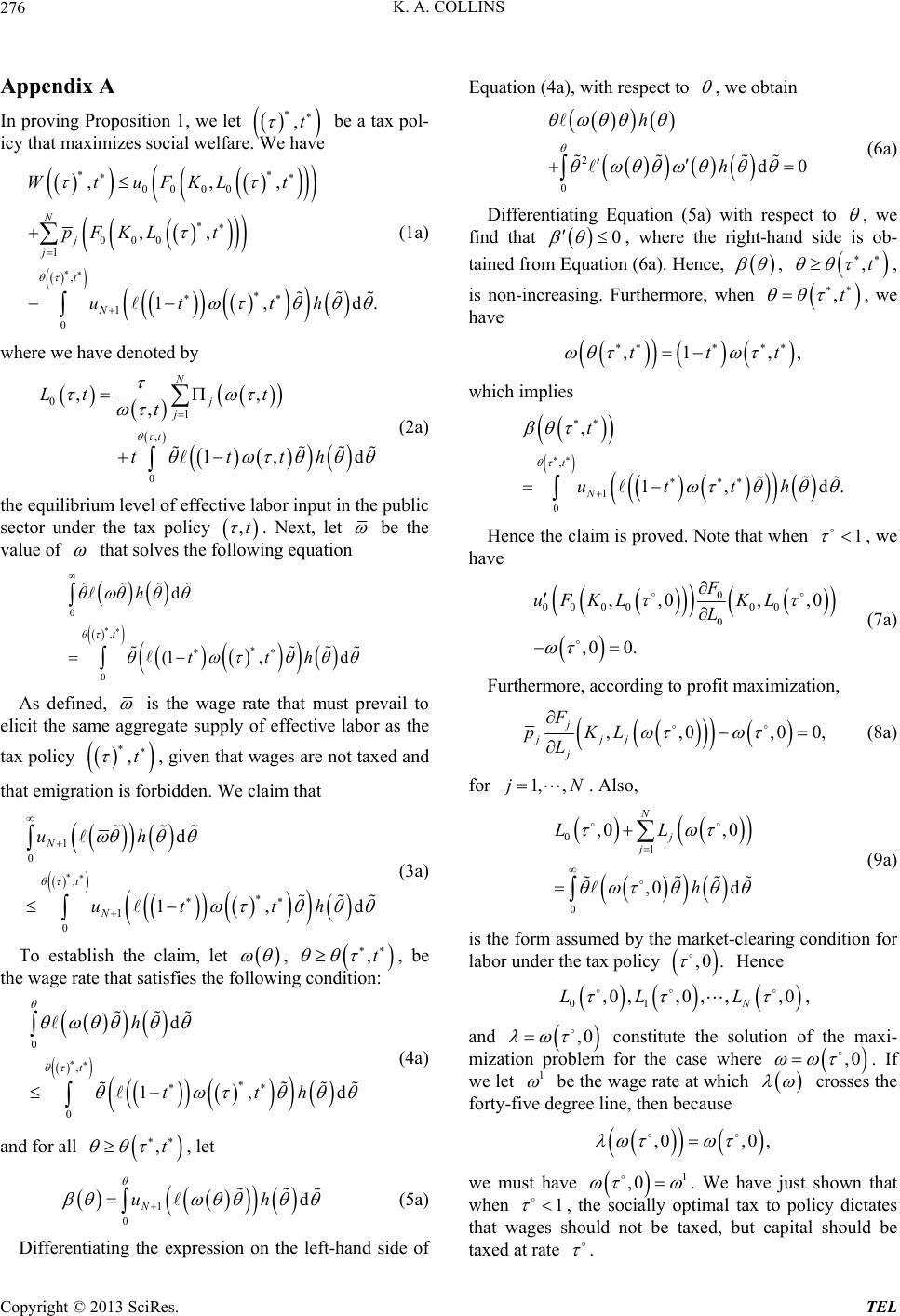 K. A. COLLINS 276 Appendix A In proving Prop osition 1, we let be a tax pol- icy that maximizes social welfare. We have ,t 00 00 000 1 , 1 0 ,,, ,, 1, N j j t N WtuFKL t pFKL t ut th d. (1a) where we ha ve denoted by 01 , 0 ,, , 1, N j j t Lt t t ttth d (2a) the equilibrium level of effective labor input in the pub lic sector under the tax policy ,t . Next, let be the value of that solves the following equation 0 , 0 d (1, d t h tth As defined, is the wage rate that must prevail to elicit the same aggregate supply of effective labor as the tax policy , given that wages are not taxed and ,t that emigration is forbidden. We claim that 1 0 , 1 0 d 1, N t N uh ut th d (3a) To establish the claim, let , ,t , be the wage rate that satisfies the following condition: 0 , 0 d 1, t h tth d (4a) and for all , let ,t 1 0 d N uh (5a) Differentiating the expression on the left-hand side of Equation (4a), with respect to , we obtain 2 0 d0 h h (6a) Differentiating Equation (5a) with respect to , we find that 0 , where the right-hand side is ob- tained from Equation (6a). Hence, , t , , is non-increasing. Furthermore, when ,t , we have ,1 ,tt ,t which implies , 1 0 , 1, t N t utth d. Hence the claim is proved. Note that when 1 , we have 0 0 00000 0 ,,0 ,,0 ,0 0. F uFKL KL L (7a) Furthermore, according to profit maximization, ,,0 ,0 j jjj j F pKL L 0, N (8a) for 1,,j . Also, 01 0 ,0 ,0 ,0 d N j j LL h (9a) is the form assumed by the market-clearing condition for labor under the tax policy ,0 . Hence 01 ,0 ,,0 ,,,0 N LL L , and ,0 constitute the solution of the maxi- mization problem for the case where ,0 . If we let 1 be the wage rate at which crosses the forty-five degree line, then because ,0,0 , we must have 1 ,0 . We have just shown that when 1 , the socially optimal tax to policy dictates that wages should not be taxed, but capital should be taxed at rate . Copyright © 2013 SciRes. TEL  K. A. COLLINS 277 Next, consider the scenario . This scenario oc- curs when 1 0 0 00000 0 , 1,0, 1,0 1, 00. uFKL KL L (10a) If inequality holds in Equation (10a), then the argu- ment just presented for the case can be repeated verbatim obtain the same conclusion: capital should be taxed at rate , but wa ges sh o ul d n ot be taxed. 1 1 We now claim that if Equation (10a) is a strict ine- quality, then the optimal tax rate on wages is positive. Indeed, if it is not optimal to tax wag es, then capital will be taxed at rate W and the optimal social welfare will be given by . However, when (10a) is a strict inequality, we must have ,0 1,0W 1, 00Wt, i.e., social welfare can be raised by also taxing wages after having taxed away all profits. Appendix B If , then obviously 1 1 , as claimed by the proposition. We now show that if , then 1 1 . To this end, suppose that the home government chooses to tax only capital and at rate 0 . We have ,0 ,0 ,0 and that both the equilibrium wage rate and the equilibrium level of the public good 0 provided rise with x . That is, as rises the tax policy induces no brain drain and raises the welfare of the workers as a group. The social welfare obtained under this tax policy is given by 00 1 00 001 ,0,0 ,0 ,0,01,0. N j j N j j Wux ux ux (11a) Differentiating Equation (11a) with respect to , we obtain 00 1 00 001 ,0 ,0 ,0 ,0,0 1 ,0 . N j j N j j Wux t ux ux (12a) Note that if , then 1 ,0 0W for all . Using this result and the fact that 1 00 001 ,0,0 1,00 N j j ux ux we can assert that if , then 00 1,0,0 0 N j j ux . Now the joint payoff for the home government and the N industry lobbies under the tax policy is given by ,0 00 1 ,0,0 ,0 ,0 . 1 N j j ux W (13a) For any , we have 00 1 ,0 ,0 ,0 ,0 0, 1 N j j ux W (14a) which has been ob tained with the help of Equation (12 a) and the fact that ,0 0W when 1 . We have just shown that the joint payoff for the home government, given that only capital is taxed, is strictly decreasing in the interval . Hence, when 1 1 , the value of , namely 1 , that solves the maximization problem in Proposition 2 must be strictly less than . Proposition 2 is now proved. Appendix C There are two cases to consider in the proof of Proposi- tion 3: 1 and 1 . When , we have 1 1 according to Proposition 2. Because , we must have 1 11 0 00 0000 0 1 ,,0,,0 ,0 0. F uFKL KL L (15a) Note that Equation (15a) also implies that 1,0 0Wt . Therefore, we claim that 11 0 00 1 111 ,0 ,0 1,0,0 N j j j x ux t Lt 0. (16a) Indeed, if this is not the case, then we must have Copyright © 2013 SciRes. TEL 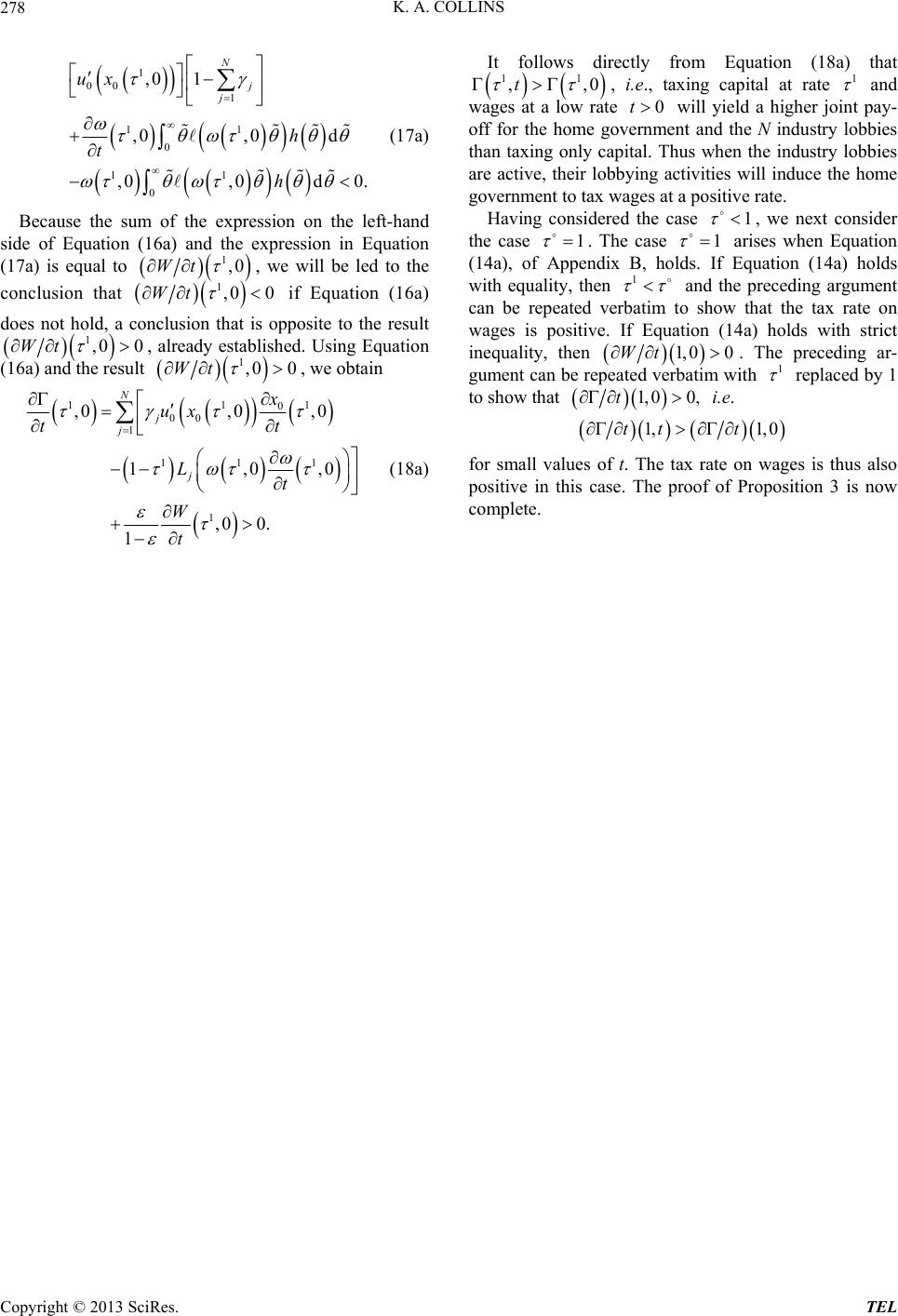 K. A. COLLINS Copyright © 2013 SciRes. TEL 278 It follows directly from Equation (18a) that 11 ,t 1 00 1 11 0 11 0 ,0 1 ,0,0 d ,0,0d 0. N j j ux h t h (17a) ,0, i.e., taxing capital at rate 1 and wages at a low rate will yield a higher joint pay- off for the home government and the N industry lobbies than taxing only capital. Thus when the industry lobbies are active, their lobbying activities will induce the home government to tax wages at a positive rate. 0t Because the sum of the expression on the left-hand side of Equation (16a) and the expression in Equation (17a) is equal to 1,0Wt , we will be led to the conclusion that 1,0 0Wt if Equation (16a) does not hold, a conclusion that is opposite to the result 1,0 0Wt , already established. Using Equation (16a) and the result 1,0 0Wt , we obtain 11 0 00 1 111 1 ,0,0 ,0 1,0 ,0 0. 1 N j j j x ux tt Lt W t 1 ,0 (18a) Having considered the case , we next consider the case 1 1 . The case arises when Equation (14a), of Appendix B, holds. If Equation (14a) holds with equality, then 1 1 and the preceding argument can be repeated verbatim to show that the tax rate on wages is positive. If Equation (14a) holds with strict inequality, then 01, 0Wt . The preceding ar- gument can be repeated verbatim with 1 replaced by 1 to show that 1, 0t0, i.e. 1,1, 0tt t for small values of t. The tax rate on wages is thus also positive in this case. The proof of Proposition 3 is now complete.
|